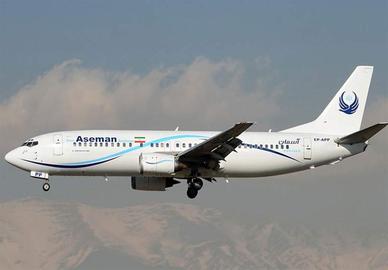On February 18, an Iran Aseman Airlines’ ATR 72-500 crashed into the Dena mountains approaching Yasuj Airport in Isfahan province after taking off from Tehran’s Mehrabad Airport, killing 66 people.
It was a fresh reminder of the dire realities of the country’s aviation industry, and followed an incident just days before, in which a Qeshm Air Fokker 100 was forced to make an emergency landing at Mashhad Airport.
Iranians quickly went on to social media to share photographs and videos clips of both the crash and the emergency landing. But outside the sphere of raging rumors, not much else was said. For a country with so many airplane crashes, there is little expert opinion available about the technical reasons for these incidents.
The International Civil Aviation Organization (ICAO) reports that in 2017, there was one fatality per 16 million flights. That year, there was a total of 152 incidents around the world. In the first two months of 2018, there were 17 incidents, the Iran Aseman Airlines crash being the 17th. So far, Iranian fatalities make up 45 percent of the total air crash fatalities in 2018. And over the last decade, the ICAO reports that there have been 20 airplane crashes in Iran, with a total of 303 fatalities. These incidents make up two percent of the total number of airplane crashes in the world for the period between 2009 and 2018. Iran’s share of fatalities is six percent. In other words, an airplane incident in Iran is three times more likely to have a fatality when compared to the global average.
As sanctions intensified between 2008 and 2010, Iran’s aviation industry suffered a number of incidents and accidents. Many believed these were caused by an aging air fleet and lack of parts for maintaining aircraft standards. When Iran and the P5+1 countries (the United States, the United Kingdom, France, Russia, China, plus Germany) reached a nuclear deal in 2015, which led to the implementation of the Joint Comprehensive Plan of Action (JCPOA), many thought these sorts of incidents would stop. But they didn’t, and it is clear that the blame cannot be put wholly on the model of aircraft involved in any given incident.
The ATR 72 aircraft is produced by a joint French-Italian venture. Since its introduction in the 1980s, 944 ATR 72s have been built and gone into operation. In total, the aircraft has been involved in 15 accidents. A variety of airlines have ATR 72s as part of their fleets, flying them in all sorts of climates, from the cold winters of Scandinavia to tropical weather in parts of Africa. Its performance and versatility has encouraged Iran Air, Iran’s national flag carrier, to place an order for 20 ATR 72-600 airplanes since the JCPOA was implemented. So far, Iran Air has purchased and received eight ATR 72-600s, and has given them the nickname Butterfly. With its fleet of Butterflies, the airline has introduced several new routes to less developed parts of the country. Defending their decision to place an order for the 20 newer planes, some Iran Air airline executives pointed at the age of the recently crashed Iran Aseman Airlines’ ATR 72-500. They argued that, before it crashed, the airplane had been grounded due to lack of parts, and said that the age of the aircraft made it unreliable.
Iran’s Civil Aviation Organization (IR-CAO) tends to blame airplane crashes on pilots, who are often killed in the accidents. Iranian media argue that the age and the type of aircraft are the most important causes of these incidents. Few even venture to discuss the industry’s decision-making process or flight safety standards. For all the accidents that occur in Iran, there has not been one single post-accident report that covers all aspects of a flight, from airport to flight control to operations.
Bans Haven't Helped
Maybe that is the reason behind IR-CAO’s capricious edicts. In summer 2009, following several airplane crashes, two of which involved Russian made airplanes, IR-CAO banned the use of Russian-made aircraft in Iran. However, this did not mean the Iranian version of the Antonov-140 — known as IrAN-140 — was taken out of service. The aircraft continued to be used, despite the fact that its Klimov turboprops regularly overheated, and despite the fact that there had been three fatal incidents involving IrAN-140 planes, killing all on board and resulting in the total destruction of the planes. Then, in summer 2014, there was another fatal accident. An IrAN-140 crashed seconds after taking off from Mehrabad airport, killing all on board. Shortly after, the Iranian government (not IR-CAO) banned the aircraft from use. But whether planes are banned by the IR-CAO or the government, many analysts say that such moves are useless and do little to solve the problem. Following the bans, Iranian airlines replaced their fleets of Russian and Ukrainian planes with aging Airbus 320 and MD 82/88 aircraft.
Only one year after the Russian aircraft was banned, Iranians mourned another significant loss of lives. An Iran Air Boeing 727-100 crashed at Urmia Airport. The cause: ice on the wings. And other Western-made airplanes continue to crash in Iran. They skid off runways, lose engine power, or experience malfunctions in their landing gear. These all are signs of poor maintenance and safety checks, rather than hazardous aviating. But there is seldom a report on the technical aspects or accurate timelines of these airplane incidents in Iran. One inquiry from Iran’s parliament did produce a rare report. The appointed committee investigated the IrAN-140, concluding something any aerospace engineer could have told them 20 years earlier: The aircraft was structurally unsuited for Iran’s dry climate, particularly because it used engines originally designed for helicopters.
The lack of transparency in air crashes extends to Iran’s aviation industry’s business practices too. Despite extensive coverage and several exposes, Iranian authorities are extremely tight-lipped when it comes to financial transactions and the orders Iran Air has placed with Airbus and Boeing — and in some cases, these orders are a considerable size. Iranian airlines have placed orders for 120 units of different types of Boeing aircraft, 173 units of different models of Airbus aircraft and 20 ATR 72-600 airplanes. Iran Air has ordered a total of 80 Boeing airplanes, 110 Airbus airplanes and 20 ATR 72-600 airplanes.
So far, Iran Air has received only three Airbus airplanes and eight ATR 72-600s. The Airbus aircraft were initially produced for other airlines that later canceled their orders for a variety of reasons, including financial shortfalls, airline mergers or specific expectations not being met in line with initial arrangements. These cancellations are a normal part of aviation deals, and as a rule airplane manufacturers take the likelihood of this happening into account. Farzaneh Sharafbafi, Iran Air’s CEO and the first woman to head this flag carrier, said that the initial payments for these airplanes had been made possible by Iran’s National Development Fund, which is financed by the government’s oil revenues. A source in the Iran Air finance department told IranWire: “Iran Air cannot fund the down payment for the rest of its orders on its own.” This could be a potential reason why Iran Air executives and Iranian authorities continue to negotiate with Airbus about using the aircraft manufacturer’s credit lines to finance the order. Such an arrangement does seem feasible, as Iran continues to work with the Financial Action Task Force (FATF), an international watchdog that focuses on money laundering and financial benefits produced through terrorism, and since the international community still blacklists its banks. The fact that no European bank has publicly stepped forward to act as the necessary banking channel further hampers these efforts.
Farzahane Sharafbafi has revealed that Iran Air has received licenses from the United States’ Office of Foreign Assets Control to receive 38 Airbuses, 15 Boeings, and 20 ATR 72-600s by the end of 2020. These orders comprise one-fifth of total orders for Boeing aircraft and two-fifths of total orders for Airbus planes. Even if Iran Air receives these airplanes, a scenario that is increasingly improbable because of financial challenges, it will still need to use many of its old airplanes in its fleet to operate all of its routes.
At the present time, Iran Air is busy demonstrating the economic benefits of the JCPOA instead of devising a competitive strategy. Iranian politicians and the Iranian public believe that Iran provides the most natural air transit flight paths for the region. And yet regional airlines have shown that they can easily switch to Iraq or Pakistan airspace and do not need to fly over Iranian airspace. The fact that the Iranian government based its priorities in aviation on politics and not on economic realities has contributed to Iran’s diminished aerial fortunes. And for this reason, transparency and confidence-building do not rank high on the priority list in Tehran.
And this is the tragedy. The recent crash in Yasuj just confirms the sad truth that even with the implementation of the JCPOA and lifted sanctions, airplane disasters and more minor incidents continue. Iranians still mourn their loved ones as new airplanes for use on Iranian fleets arrive at Mehrabad Airport.
visit the accountability section
In this section of Iran Wire, you can contact the officials and launch your campaign for various problems

























comments